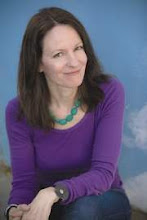 levels, this three-hour seminar covers the steps necessary for writers who are ready to send out their fiction and nonfiction for publication." It was a great crowd, attentive, with lots of questions. (And they bought every copy of Quinn's book, Stores from the Afterlife, that we had on hand.) Quinn, who drove down from Greensboro, NC, was a real champ. She is, as I explained to the crowd when I introduced her, one of the hardest working writers I know.
levels, this three-hour seminar covers the steps necessary for writers who are ready to send out their fiction and nonfiction for publication." It was a great crowd, attentive, with lots of questions. (And they bought every copy of Quinn's book, Stores from the Afterlife, that we had on hand.) Quinn, who drove down from Greensboro, NC, was a real champ. She is, as I explained to the crowd when I introduced her, one of the hardest working writers I know.Quinn's books include a novel, “High Strung” (Simon & Schuster), and two short story collections, “Bulletproof Girl” (Simon & Schuster) and “Stories from the Afterlife” (Press 53). “New Stories from the South: The Year's Best, 2006,” includes one of her stories.
Here's an article I wrote about Quinn for the Greenville Journal:

Quinn Dalton is downright sly when it comes to writing: “I’m like a teenager looking to sneak out when it comes to writing. I do it when I get the chance. I’m looking for the opportunity all the time and if it turns out to be 15 min, I’ll take it. That said, some days I don’t get a window at all. It’s OK—you get to do a lot of writing in your head, too, thank goodness.”
At 36, Dalton has written a novel and short story collection, both of which were published by Simon & Schuster. A third collection of short stories, "Stories from the Afterlife," was published in November by Press 53. Dozens of her short stories have appeared in literary magazines. Her essays and articles have appeared in publications such as Poets & Writers, The Writer magazine, and Media Bistro. She is equally savvy when it comes to new media; her name regularly appears on literature blogs across North America.
How does she do it? Dalton, who lives in Greensboro, NC with her husband and two young daughters, keeps several projects—nonfiction and fiction—going at once. “If I get stuck on one thing I can turn to something else,” she said. “The nonfiction I write is usually centered around business articles or writing craft—I find nonfiction isn’t that difficult because you have a point to make. With fiction, long or short, you don’t necessarily know what the thing will become. So in that way it’s harder because you have to have faith. With a novel, I think it’s more of a day-to-day relationship. You have to show up every day. But the work doesn’t disappear if you decide you need to take a break.”
Dalton will be in Greenville to lead a seminar, “Pitching and Placing Your Writing,” for the Writing Room on January 13, where she plans to share strategies about sending work out. For example, she keeps a list of publications to target her submissions. “I send to magazines that have a shorter response, less than three to four months. I avoid magazines that object to simultaneous submissions. From there, the page length of my submission and the times when magazines are accepting submissions narrows down the list further. I tend to send a story at least four to five places at one time.”
There’s a crucial point to keep in mind when submitting articles and essays, as opposed to fiction, she said. “When you pitch nonfiction, you’re pitching an idea. You have to identify the outlet--magazine or broadcast, for example--and the journalist/editor who will be most responsive, and angle the pitch to their needs. It’s not easier, but I think it’s more straightforward than placing fiction.”
Dalton also reminds writers their work doesn’t stop upon publication. When her collection, “Stories from the Afterlife,“ was published by Press 53, she discovered the small, literary publisher in North Carolina was “more hands on, face-to-face, and in general, more fun,” than working with a large publisher. “Don’t think I wasn’t thrilled to debut with a big house (Simon & Schuster), because if that hadn’t happened, no small press would have been seeking me out. But I have enjoyed feeling more like an equal with my publisher, and figuring out what we wanted to do together rather than having it dictated to me.”
“New Stories from the South: The Year's Best, 2006” includes a story from Dalton’s “Stories From the Afterlife.” Such an honor is thrilling, Dalton said, “Especially because the editor who selected my story, Allan Gurganus, is a writer I especially admire.”







Mindy, thanks so very much for hosting Quinn last week and for posting this excellent article. We appreciate it!
ReplyDeleteSheryl Monks
Publisher/Editor
Press 53
www.press53.com